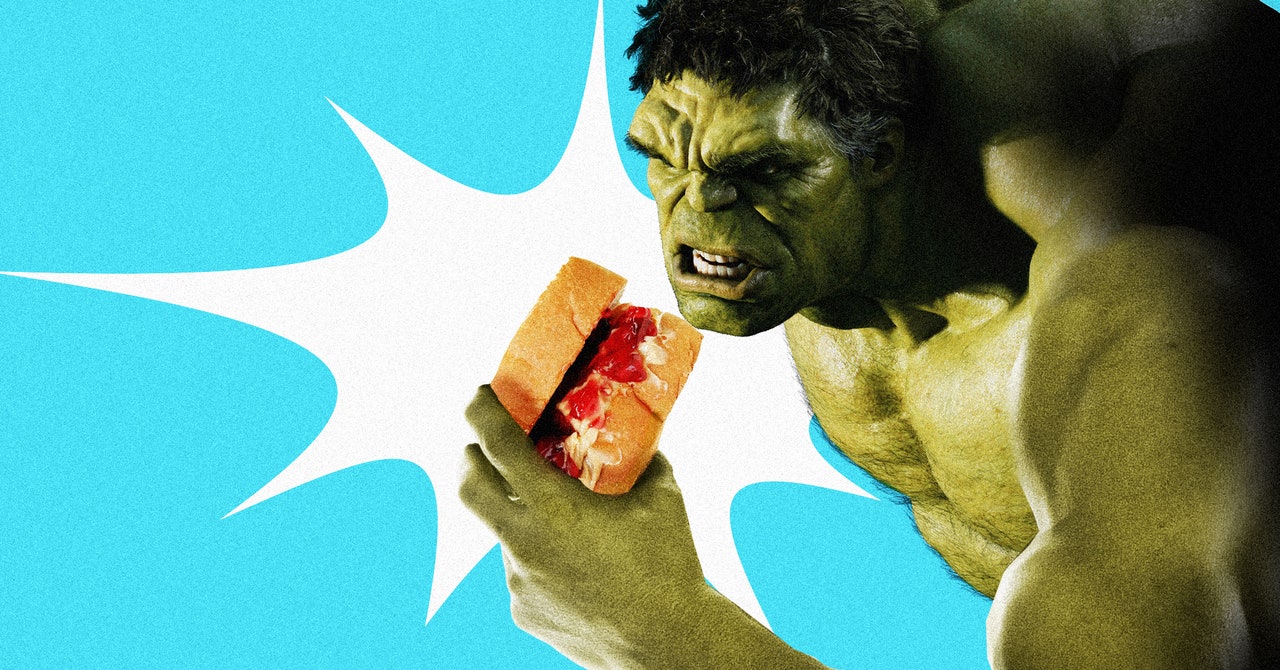
Superheroes do superhero things: They jump, punch stuff, run fast, and sometimes shoot beams out of their eyes. These activities require energy, just like normal human activities. When you get up in the morning, that takes energy. Walking around takes energy. Running a mile requires even more energy—but not nearly as much as it would take to fly a human-powered helicopter for one minute. (Yes, that’s real.) All of that energy comes from food. If superheroes also get their energy from food, just how much would they need to eat to pull off their high-energy moves?
In honor of the new Disney+ series that started August 17, I’m going to focus on moves by the Hulk and She-Hulk. I think we can assume that the two of them get their energy from food. A recent clip from the series shows the Hulk (Bruce Banner) telling She-Hulk (Jennifer Walters) that they can drink as much alcohol as they want, since hulks have such a high metabolism. That implies their energy comes from eating and not some strange mechanism or source, like an extra dimension.
Food Energy
We measure the energy in food in terms of calories. For example, the wrapper on a single candy bar may say a serving has 200 calories. (Here are some examples with exact values.)
But there’s a difference between the way nutritionists talk about calories and the way physicists do. To physicists, a calorie is the amount of energy that you would need to raise the temperature of 1 gram of water by 1 degree Celsius. But that’s not the same as a food calorie. Food labels actually list things in terms of kilocalories, which means the 200-calorie candy bar is really 200 times 1,000 calories, or 200,000 calories.
That’s confusing. And to be honest, we physicists don’t really like to use either of these units for energy. Instead, we often use joules, where 1 joule is equal to the energy needed to push with a force of 1 newton over a distance of 1 meter. Lifting a textbook off the floor and putting it on a table takes about 10 joules of energy. One food calorie is equal to about 4,184 joules.
But for this demonstration, I think it’s best if we make up our own unit of energy. Let’s call it the PBJ—the peanut-butter-and-jelly-sandwich unit of energy. This is the amount of energy you get from eating one of these sandwiches, which is around 380 food calories or 1.59 million joules. With this PBJ unit, I can calculate the energy cost of superhero moves in terms of sandwiches. I just think that will be fun.
Energy Needed for Nothing
Simply staying alive requires energy: to breathe, pump blood, and even blink your eyes. The amount of energy it takes is called the basal metabolic rate, or BMR. A typical mortal human could have a BMR of around 1,500 to 2,000 food calories a day. Converting to my preferred energy unit, a person uses about 4 to 5 PBJs a day. (Your mileage may vary.)
A BMR value depends on a person’s age, weight, and height—but the Hulk and She-Hulk aren’t normal-sized humans, so they won’t have normal BMRs. Let’s figure out their weights and heights.


